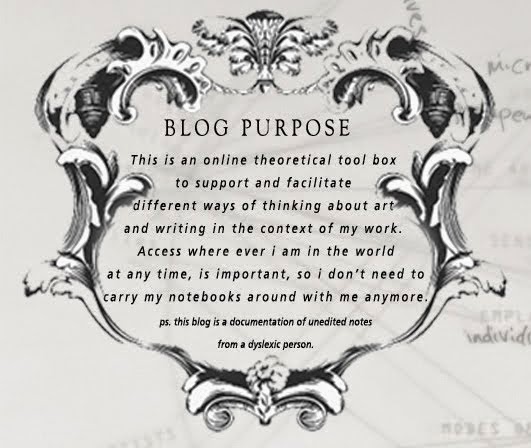Mieke Bal background research:
http://www.miekebal.org/research/areas-of-interest/
Cultural theorist
and critic
Video artist . Royal Netherlands Academy of Arts and Sciences Professor (KNAW), 2005-2011. Based at the Amsterdam School for Cultural Analysis (ASCA), University of Amsterdam.
Video artist . Royal Netherlands Academy of Arts and Sciences Professor (KNAW), 2005-2011. Based at the Amsterdam School for Cultural Analysis (ASCA), University of Amsterdam.
Mieke’s
experimental documentaries on migration include A Thousand and One Days;
Separations; Colony, and the installation Nothing is Missing as part of the Cinema Suitcase collective. Her work
is exhibited internationally. Her recent work is the Mère Folle project, an
international project on madness that includes the ‘theoretical fiction’
feature film A Long History of
Madness, installations and research.
Travelling
Concepts: This project results from my intense involvement with PhD
training, both in the context of the ASCA Theory
Seminar and in a large number of individual PhD projects. Through these
pedagogical activities - in the Netherlands traditionally and oddly credited as
‘research’, not as teaching - I have developed insight into the indispensable
contribution that can be expected to be made from reflecting on and deploying
concepts in interdisciplinary cultural analysis. In 2002 I published a book on this topic
called ‘Travelling Concepts in the Humanities: A Rough Guide’ (University of
Toronto Press, the publisher of my previous pedagogically oriented work), which
consists of an argument in favour of this view.
A series of case studies
demonstrates the consequences of replacing paradigm- and discipline-based
methodologies with an open re-examination of concepts that have a history of
‘travelling’ between disciplines, historical periods and contexts, and even
cultures. Under the rubric ‘travelling concepts’ I work on incidental, often
commissioned papers. Political Art: My current writing project is a trilogy on the question of political art. I seek to understand and advocate art that is political without being thematically about politics.
In each volume, a contemporary artist is central in order to examine the question in close dialogue with art of the present. All three artists (Eija-Liisa Ahtila, Doris Salcedo and Ann Veronica Janssens) are strongly committed to deploy space as their medium; one in sculpture, one in video installation, and one in abstract spatial interventions.Migratory Aesthetics: The mixed societies that have emerged as the result of migration have benefited enormously from the arrival of people from many different cultures. Cities have become more heterogeneous (‘colourful’), music and cinema have been enriched and philosophy gratefully uses the potential offered by thinking along the lines of - and through metaphors relating to - migrancy.
Theorizing itself opens up its creativity thanks to the need to shed the limitations harboured by local habit. There is an aesthetic to thought as much as to, say, fashion, film, or food.This project examines the positive impact on the everyday that comes with migration, the now-common state of hybridity (where speaking of origins becomes almost forced and often impossible) and the small yet significant aspects of everyday culture and thought that are ‘foreign’ in origin but are no longer ‘foreign’. In a sense, these aspects are beyond identity but carry traces of foreignness. Much of my video work centres on this cultural transformation.
In Time: Between Performance and Performativity
Performance is not; it occurs. It happens and takes time. It has a past and a future, and hence, a present. From linguistics and the philosophy of language, we take the notion that utterances do something: they perform an act that produces an event.From theatre, we borrow the notion of role-playing, which can be extended to include social role-playing, then restricted it to that aspect of playing that is effective in that it affects the viewer. From anthropology, we take the idea that the performative speech act, in the extended sense, requires the participation in the production of meaning, of the ethnographer’s partner, that is, of the people belonging to or temporarily dwelling in the culture studied.
In art, this entails the indispensable participation of the visitor to the museum or the viewer of the work, without whom the artwork is simply nothing, just a dead object. In this project, then, due to this triple allegiance, the notion of ‘performance’ will be taken in all its ambiguity. The term encompasses ‘performativity’ as opposed to being distinct from it. I have tentatively worked with this cluster of aspects of the two terms in several recent articles on contemporary art not bound to specific traditional media.
My ongoing video installation project ‘Nothing is Missing’ explores performativity in the process of documenting speakers who talk on camera on very private matters. I am also working on three books arguing that it is the performative aspect of art that gives it political agency.
-------------------
Multiple-screen video installation, 25–35 minutes (looped), 2006–2010
Multi-lingual with English subtitles
http://www.miekebal.org/artworks/installations/nothing-is-missing/
-------------------
back cover text:
Travelling Concepts in the Humanities: A Rough Guide
Toronto: University of Toronto Press, 2002back cover text:
‘Travelling Concepts in the
Humanities’ is intended as a guidebook for interdisciplinary cultural
analysis in the humanities. In this challenging work, Mieke Bal analyses
a variety of concepts - such as meaning, metaphor, narrative, and myth -
that ‘travel’ from one discipline to another. To illustrate the
possibilities of these concepts, she provides examples drawn from a
number of disciplines, including literary criticism, art history, and
visual studies. Interdisciplinarity, she argues, must seek its heuristic
and methodological basis in concepts rather than in methods.
This is not only a guidebook, but also a story of
adventure: we are witnesses as concepts travel into or through visual
studies (or the cultural practice of art), displaying their
possibilities through a series of fascinating case studies. Returning
from our travels we find that the object constructed no longer is the
‘thing’ that we chose; it has become a living creature, embedded in new
questions and considerations.
This lively, wide-ranging, and innovative study will
be of interest to scholars in a variety of disciplines, including
literary studies, art history, biblical studies, feminist theory, and
visual and cultural studies.

